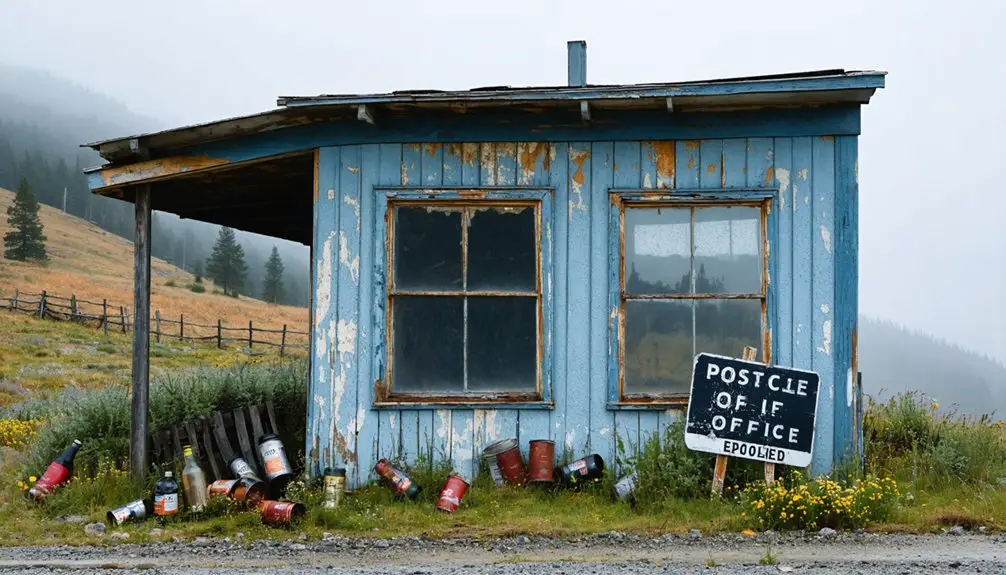You’ll find Orodell’s ghost town remnants in northeastern Oregon’s mountainous terrain near La Grande. This former lumber mill town emerged in the 1860s when William S. Odell and Dave Turner established the first settlement. The community thrived with a sawmill, store, blacksmith shop, church, and post office until its decline in the late 1870s. Its name combines the Greek “oros” (mountain) and English “dell” (valley), reflecting the natural landscape that holds many untold stories.
Key Takeaways
- Orodell was established in 1867 near La Grande, Oregon, combining Greek “oros” (mountain) and English “dell” (valley) to describe its location.
- The town flourished briefly as a lumber production center with essential services including a store, blacksmith shop, church, and post office.
- A sawmill established in 1862 drove the town’s economic growth until its closure in the late 1870s.
- Orodell experienced rapid abandonment after the sawmill closed, with the post office’s closure in 1878 marking the end of operations.
- The ghost town site, located in northwest La Grande, is now surrounded by mixed coniferous forests and the Grande Ronde River.
Origins and Etymology of Orodell’s Name
Etymology reveals that Orodell’s unique name combines the Greek root “oros,” meaning mountain, with the English word “dell,” meaning a small wooded valley.
You’ll find this name significance reflects the settlement’s natural surroundings, where mountainous terrain meets the Grande Ronde River valley.
The name’s cultural influences stem from 19th-century settlers’ classical education and their desire to create meaningful place names.
When establishing the post office in 1867, they chose this distinctive Greek-English hybrid over purely Indigenous or English terms.
The term appears in various historical documents that detail the region’s development and settlement patterns.
While you might occasionally see it written as “Oro Dell,” the combined form “Orodell” became the standard spelling in official records.
The name’s descriptive nature served practical purposes, helping pioneers navigate Oregon’s frontier while capturing the essence of the local geography.
Located in Union County, Orodell exemplifies the region’s commitment to preserving its historical identity.
Early Settlement and Industrial Beginnings
As Orodell’s name reflected its mountainous valley setting, the physical landscape would shape the patterns of its early settlement.
You’ll find that the first European-American settlers arrived around 1860-1861, with pioneers like William S. Odell and Dave Turner leading the way from California. These early settlers faced significant challenges, dealing with dense underbrush and forest while establishing their community near natural landmarks and Indian trails. The area’s native inhabitants had long established successful seasonal food gathering practices in the region.
Community growth emerged through the development of essential services. By 1867, you’d have found a store, blacksmith shop, church, lodge, school, and post office clustered together at key crossroads. The settlers discovered an area where trees’ lower limbs had been removed up to 20 feet high, which local Indians later revealed was used as a gathering place during harsh winters.
Essential frontier services quickly sprang up in Orodell, creating a bustling hub where crossroads met the needs of settlers.
The area’s first industrial venture, a sawmill, began operating in 1862, marking an important milestone in Orodell’s economic development despite the transportation difficulties posed by the surrounding forests.
The Rise of Lumber Production
While the first sawmill in Orodell marked a modest beginning in 1862, the arrival of railroads in the 1880s transformed the region’s lumber industry into a powerhouse of production.
You’ll find that technological advances like steam donkeys and crosscut saws dramatically increased timber harvesting efficiency. The lumber production surge created a robust timber industry that helped Oregon become the nation’s leading wood producer by 1938. Basic logging tools like single-bitted axes were gradually replaced as operations modernized. Oregon’s timber industry flourished alongside the California Gold Rush, which drove substantial demand for lumber.
- Northern Pacific’s arrival in Portland (1883) opened access to previously untapped forest resources
- Steam-powered equipment and specialized mill machinery boosted production capabilities
- Scandinavian-trained workers brought expertise to operate advanced milling equipment
- Multiple logging camps employed hundreds of workers, driving economic growth
Despite periodic economic challenges like the Great Depression’s impact on lumber markets, Orodell’s timber industry remained resilient through technological innovation and strategic railroad connections.
Life in a 19th Century Mill Town
If you’d lived in Orodell during its heyday, you’d have woken to the distant hum of sawblades and the shouts of mill workers starting their dawn shifts.
You’d have navigated daily life around the constant timber operations, with the sounds of falling trees and the sight of log-laden wagons becoming part of your routine backdrop. The transportation of lumber relied heavily on primitive road systems until the mid-1850s. As steam-powered technology advanced, the town saw the introduction of Clyde four-line skidders that could move logs from impressive distances at high speeds.
Your family would have adapted to the mill town’s rhythms, likely sharing your modest home with other workers’ families while managing household chores without modern conveniences like running water or electricity.
Daily Mill Worker Activities
Mill workers endured grueling 10-14 hour workdays filled with dangerous, repetitive tasks that began before sunrise.
You’d spend your days performing intense manual labor while dodging serious safety hazards like heavy machinery, falling timber, and toxic sawdust. The constant roar of saws and engines made communication difficult as you sorted logs, operated circular saws, and loaded lumber onto rail cars. Workers often faced severe financial penalties for even minor infractions like talking during shifts. Labor unions emerged to fight for better working conditions and worker protections.
- Maintaining equipment and sharpening saw blades before the day’s first cut
- Hauling and stacking lumber while avoiding injury from falling timber
- Working through minimal breaks with cold lunches eaten near the mill
- Cleaning machinery and preparing for the next shift after sunset
The physical demands took their toll, with wet clothing, inadequate safety measures, and the ever-present risk of accidents or respiratory problems from constant dust exposure.
Living Around Timber Operations
Life in a 19th century timber town meant residing in company-owned housing near the bustling mill operations, where you’d find yourself part of a close-knit but isolated community.
You’d shop at the company store, buying necessities on credit against your wages, while your children attended the local one-room schoolhouse.
The timber community dynamics revolved around the mill’s schedule, with your daily life punctuated by the sounds of logging operations and sawmill machinery.
Mill town challenges included dealing with dusty air, primitive sanitation, and basic amenities.
You’d face seasonal disruptions when weather blocked transportation routes, and you’d need to adapt to economic uncertainties when timber markets fluctuated.
Despite these hardships, you’d find community support through company-organized events and shared experiences with fellow mill families.
From Bustling Town to Abandonment

While Orodell initially showed promise as a bustling frontier settlement, its shift to abandonment unfolded rapidly in the late 1870s.
The community dynamics changed dramatically as economic challenges mounted, particularly after the closure of the sawmill that had been the town’s lifeblood.
You’ll find that Orodell’s decline mirrored many resource-dependent settlements of the era that couldn’t adapt to changing market conditions.
- The post office’s closure in 1878 marked the end of official town operations
- Residents quickly relocated to seek opportunities in other communities
- All significant structures fell into disuse and eventually disappeared
- No preserved buildings remain to mark the town’s former existence
Today, you’ll find only historical records and maps to remind you of this once-promising lumber town’s existence in Union County.
Geographic Features and Natural Surroundings
The geographic setting of Orodell reveals why settlers initially chose this location for their frontier community.
You’ll find this ghost town nestled in the northwest corner of La Grande, Oregon, where the Grande Ronde River carves through the mountainous landscape at coordinates 45°20′34″N, 118°06′49″W.
The town’s name itself reflects its surroundings, combining the Greek word for mountain with “dell,” aptly describing its valley terrain.
The river ecosystems played a significant role in the settlement’s development, particularly supporting the sawmill established in 1862.
Today, you can observe how the mixed coniferous forests and rolling hills embrace the abandoned townsite, while diverse wildlife thrives in the riparian zones along the Grande Ronde River.
The Pacific Northwest climate continues to shape this dynamic landscape, preserving the natural character that first attracted pioneers.
Historical Legacy in Union County

Since its establishment in the 1860s, Orodell played a pivotal role in Union County’s early development through its pioneering lumber industry. The town’s economic impact was significant but short-lived, as La Grande’s selection for railroad yards in 1884 led to Orodell’s community decline.
Today, you’ll find only remnants of this once-thriving settlement, with visible foundations on the hillsides serving as proof of its historical significance.
- First sawmill operation in Grande Ronde Valley (1862) sparked regional lumber industry development
- Served as an essential business center and stock marshalling point during the 1870s mining era
- Post office operation (1867-1878) marked the peak of community viability
- Historical preservation efforts continue through local historical society projects and regional archives
Frequently Asked Questions
Are There Any Remaining Structures or Ruins Visible at the Orodell Site?
While you might hope to explore historic remnants, no remaining structures or visible ruins are documented at the site today – decades of abandonment and typical ghost town deterioration have erased physical traces.
What Was the Peak Population of Orodell During Its Most Active Period?
You’ll find no confirmed peak population records for Orodell’s period of growth, though similar lumber towns in Union County suggest it likely peaked at several hundred residents before population decline began.
Did Any Notable Historical Figures or Pioneers Live in Orodell?
You’ll find only Charles Fox and Stephen Coffin made notable pioneer contributions as the town’s first sawmill operators. Beyond these entrepreneurs, historical records don’t show any other significant residents living in Orodell.
Were There Any Significant Native American Settlements Near Orodell Before Establishment?
You’ll find evidence of thriving Native American settlements along the Columbia River near this area, where indigenous peoples fished, hunted, and gathered seasonally for thousands of years before colonial expansion.
What Transportation Routes Connected Orodell to Other Communities in the Region?
You’ll find wagon roads were the primary transportation routes linking the town to La Grande, with the regional connectivity later enhanced through nearby rail networks and improved highways.
References
- https://www.wikiwand.com/en/articles/Orodell
- https://en.wikipedia.org/wiki/Orodell
- https://www.youtube.com/watch?v=pmmXI-V7Gdc
- https://en.wikipedia.org/wiki/List_of_ghost_towns_in_Oregon
- https://kids.kiddle.co/List_of_ghost_towns_in_Oregon
- https://www.loquis.com/en/loquis/6605831/Orodell+Oregon
- https://traveloregon.com/things-to-do/culture-history/the-meaning-behind-oregons-place-names/
- https://bakercityherald.com/2025/07/25/column-the-oregonian-slights-sumpter-with-its-most-famous-ghost-town-claim/
- http://www.gorgeconnection.com/odell/history.php
- https://www.oregonhistoryproject.org/narratives/central-oregon-adaptation-and-compromise-in-an-arid-landscape/finding-central-oregon/prehistory/



